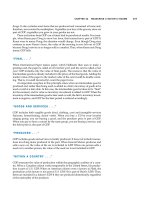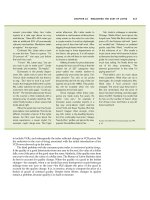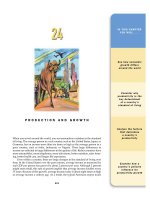Ten Principles of Economics - Part 53
Bạn đang xem bản rút gọn của tài liệu. Xem và tải ngay bản đầy đủ của tài liệu tại đây (220.25 KB, 10 trang )
CHAPTER 24 PRODUCTION AND GROWTH 539
investment. (Or, perhaps, high growth and high investment are both caused by a
third variable that has been omitted from the analysis.) The data by themselves
cannot tell us the direction of causation. Nonetheless, because capital accumula-
tion affects productivity so clearly and directly, many economists interpret these
data as showing that high investment leads to more rapid economic growth.
DIMINISHING RETURNS AND THE CATCH-UP EFFECT
Suppose that a government, convinced by the evidence in Figure 24-1, pursues
policies that raise the nation’s saving rate—the percentage of GDP devoted to
saving rather than consumption. What happens? With the nation saving more,
fewer resources are needed to make consumption goods, and more resources are
available to make capital goods. As a result, the capital stock increases, leading to
rising productivity and more rapid growth in GDP. But how long does this higher
rate of growth last? Assuming that the saving rate remains at its new higher level,
does the growth rate of GDP stay high indefinitely or only for a period of time?
The traditional view of the production process is that capital is subject to
diminishing returns: As the stock of capital rises, the extra output produced from
an additional unit of capital falls. In other words, when workers already have a
large quantity of capital to use in producing goods and services, giving them an
additional unit of capital increases their productivity only slightly. Because of
diminishing returns, an increase in the saving rate leads to higher growth only for
a while. As the higher saving rate allows more capital to be accumulated, the ben-
efits from additional capital become smaller over time, and so growth slows down.
In the long run, the higher saving rate leads to a higher level of productivity and income,
but not to higher growth in these variables. Reaching this long run, however, can take
quite a while. According to studies of international data on economic growth,
increasing the saving rate can lead to substantially higher growth for a period of
several decades.
The diminishing returns to capital has another important implication: Other
things equal, it is easier for a country to grow fast if it starts out relatively poor.
This effect of initial conditions on subsequent growth is sometimes called the
catch-up effect. In poor countries, workers lack even the most rudimentary tools
and, as a result, have low productivity. Small amounts of capital investment would
substantially raise these workers’ productivity. By contrast, workers in rich coun-
tries have large amounts of capital with which to work, and this partly explains
their high productivity. Yet with the amount of capital per worker already so high,
additional capital investment has a relatively small effect on productivity. Studies
of international data on economic growth confirm this catch-up effect: Controlling
for other variables, such as the percentage of GDP devoted to investment, poor
countries do tend to grow faster than rich countries.
This catch-up effect can help explain some of the puzzling results in Figure 24-1.
Over this 31-year period, the United States and South Korea devoted a similar
share of GDP to investment. Yet the United States experienced only mediocre
growth of about 2 percent, while Korea experienced spectacular growth of more
than 6 percent. The explanation is the catch-up effect. In 1960, Korea had GDP per
person less than one-tenth the U.S. level, in part because previous investment had
been so low. With a small initial capital stock, the benefits to capital accumulation
were much greater in Korea, and this gave Korea a higher subsequent growth rate.
diminishing returns
the property whereby the benefit
from an extra unit of an input
declines as the quantity of the
input increases
catch-up effect
the property whereby countries
that start off poor tend to grow
more rapidly than countries
that start off rich
540 PART NINE THE REAL ECONOMY IN THE LONG RUN
This catch-up effect shows up in other aspects of life. When a school gives an
end-of-year award to the “Most Improved” student, that student is usually one
who began the year with relatively poor performance. Students who began the
year not studying find improvement easier than students who always worked
hard. Note that it is good to be “Most Improved,” given the starting point, but it is
even better to be “Best Student.” Similarly, economic growth over the last several
decades has been much more rapid in South Korea than in the United States, but
GDP per person is still higher in the United States.
INVESTMENT FROM ABROAD
So far we have discussed how policies aimed at increasing a country’s saving rate
can increase investment and, thereby, long-term economic growth. Yet saving by
domestic residents is not the only way for a country to invest in new capital. The
other way is investment by foreigners.
Investment from abroad takes several forms. Ford Motor Company might
build a car factory in Mexico. A capital investment that is owned and operated by
a foreign entity is called foreign direct investment. Alternatively, an American might
buy stock in a Mexican corporation (that is, buy a share in the ownership of the
corporation); the Mexican corporation can use the proceeds from the stock sale to
build a new factory. An investment that is financed with foreign money but oper-
ated by domestic residents is called foreign portfolio investment. In both cases, Amer-
icans provide the resources necessary to increase the stock of capital in Mexico.
That is, American saving is being used to finance Mexican investment.
When foreigners invest in a country, they do so because they expect to earn a
return on their investment. Ford’s car factory increases the Mexican capital stock
and, therefore, increases Mexican productivity and Mexican GDP. Yet Ford takes
some of this additional income back to the United States in the form of profit. Sim-
ilarly, when an American investor buys Mexican stock, the investor has a right to
a portion of the profit that the Mexican corporation earns.
Investment from abroad, therefore, does not have the same effect on all mea-
sures of economic prosperity. Recall that gross domestic product (GDP) is the
income earned within a country by both residents and nonresidents, whereas
gross national product (GNP) is the income earned by residents of a country both
at home and abroad. When Ford opens its car factory in Mexico, some of the
income the factory generates accrues to people who do not live in Mexico. As a
result, foreign investment in Mexico raises the income of Mexicans (measured by
GNP) by less than it raises the production in Mexico (measured by GDP).
Nonetheless, investment from abroad is one way for a country to grow. Even
though some of the benefits from this investment flow back to the foreign owners,
this investment does increase the economy’s stock of capital, leading to higher pro-
ductivity and higher wages. Moreover, investment from abroad is one way for
poor countries to learn the state-of-the-art technologies developed and used in
richer countries. For these reasons, many economists who advise governments in
less developed economies advocate policies that encourage investment from
abroad. Often this means removing restrictions that governments have imposed
on foreign ownership of domestic capital.
An organization that tries to encourage the flow of investment to poor coun-
tries is the World Bank. This international organization obtains funds from the
CHAPTER 24 PRODUCTION AND GROWTH 541
world’s advanced countries, such as the United States, and uses these resources to
make loans to less developed countries so that they can invest in roads, sewer sys-
tems, schools, and other types of capital. It also offers the countries advice about
how the funds might best be used. The World Bank, together with its sister orga-
nization, the International Monetary Fund, was set up after World War II. One les-
son from the war was that economic distress often leads to political turmoil,
international tensions, and military conflict. Thus, every country has an interest in
promoting economic prosperity around the world. The World Bank and the Inter-
national Monetary Fund are aimed at achieving that common goal.
EDUCATION
Education—investment in human capital—is at least as important as investment
in physical capital for a country’s long-run economic success. In the United States,
each year of schooling raises a person’s wage on average by about 10 percent. In
less developed countries, where human capital is especially scarce, the gap
between the wages of educated and uneducated workers is even larger. Thus, one
way in which government policy can enhance the standard of living is to provide
good schools and to encourage the population to take advantage of them.
Investment in human capital, like investment in physical capital, has an
opportunity cost. When students are in school, they forgo the wages they could
have earned. In less developed countries, children often drop out of school at an
early age, even though the benefit of additional schooling is very high, simply
because their labor is needed to help support the family.
Some economists have argued that human capital is particularly important for
economic growth because human capital conveys positive externalities. An exter-
nality is the effect of one person’s actions on the well-being of a bystander. An edu-
cated person, for instance, might generate new ideas about how best to produce
goods and services. If these ideas enter society’s pool of knowledge, so everyone
can use them, then the ideas are an external benefit of education. In this case, the
return to schooling for society is even greater than the return for the individual.
This argument would justify the large subsidies to human-capital investment that
we observe in the form of public education.
One problem facing some poor countries is the brain drain—the emigration of
many of the most highly educated workers to rich countries, where these workers
can enjoy a higher standard of living. If human capital does have positive exter-
nalities, then this brain drain makes those people left behind poorer than they oth-
erwise would be. This problem offers policymakers a dilemma. On the one hand,
the United States and other rich countries have the best systems of higher educa-
tion, and it would seem natural for poor countries to send their best students
abroad to earn higher degrees. On the other hand, those students who have spent
time abroad may choose not to return home, and this brain drain will reduce the
poor nation’s stock of human capital even further.
PROPERTY RIGHTS AND POLITICAL STABILITY
Another way in which policymakers can foster economic growth is by protecting
property rights and promoting political stability. As we first noted when we
542 PART NINE THE REAL ECONOMY IN THE LONG RUN
discussed economic interdependence in Chapter 3, production in market
economies arises from the interactions of millions of individuals and firms. When
you buy a car, for instance, you are buying the output of a car dealer, a car manu-
facturer, a steel company, an iron ore mining company, and so on. This division of
production among many firms allows the economy’s factors of production to be
used as effectively as possible. To achieve this outcome, the economy has to coor-
dinate transactions among these firms, as well as between firms and consumers.
Market economies achieve this coordination through market prices. That is, mar-
ket prices are the instrument with which the invisible hand of the marketplace
brings supply and demand into balance.
An important prerequisite for the price system to work is an economy-wide
respect for property rights. Property rights refer to the ability of people to exercise
authority over the resources they own. A mining company will not make the effort
to mine iron ore if it expects the ore to be stolen. The company mines the ore only
if it is confident that it will benefit from the ore’s subsequent sale. For this reason,
courts serve an important role in a market economy: They enforce property rights.
Through the criminal justice system, the courts discourage direct theft. In addition,
through the civil justice system, the courts ensure that buyers and sellers live up to
their contracts.
Although those of us in developed countries tend to take property rights for
granted, those living in less developed countries understand that lack of property
rights can be a major problem. In many countries, the system of justice does not
work well. Contracts are hard to enforce, and fraud often goes unpunished.
In more extreme cases, the government not only fails to enforce property rights
but actually infringes upon them. To do business in some countries, firms are
expected to bribe powerful government officials. Such corruption impedes the
coordinating power of markets. It also discourages domestic saving and invest-
ment from abroad.
One threat to property rights is political instability. When revolutions and
coups are common, there is doubt about whether property rights will be respected
in the future. If a revolutionary government might confiscate the capital of some
businesses, as was often true after communist revolutions, domestic residents have
less incentive to save, invest, and start new businesses. At the same time, foreign-
ers have less incentive to invest in the country. Even the threat of revolution can act
to depress a nation’s standard of living.
Thus, economic prosperity depends in part on political prosperity. A country
with an efficient court system, honest government officials, and a stable constitu-
tion will enjoy a higher economic standard of living than a country with a poor
court system, corrupt officials, and frequent revolutions and coups.
FREE TRADE
Some of the world’s poorest countries have tried to achieve more rapid economic
growth by pursuing inward-oriented policies. These policies are aimed at raising pro-
ductivity and living standards within the country by avoiding interaction with the
rest of the world. As we discussed in Chapter 9, domestic firms sometimes claim
they need protection from foreign competition in order to compete and grow. This
infant-industry argument, together with a general distrust of foreigners, has at
CHAPTER 24 PRODUCTION AND GROWTH 543
times led policymakers in less developed countries to impose tariffs and other
trade restrictions.
Most economists today believe that poor countries are better off pursuing
outward-oriented policies that integrate these countries into the world economy.
Chapters 3 and 9 showed how international trade can improve the economic well-
being of a country’s citizens. Trade is, in some ways, a type of technology. When a
country exports wheat and imports steel, the country benefits in the same way as
if it had invented a technology for turning wheat into steel. A country that elimi-
nates trade restrictions will, therefore, experience the same kind of economic
growth that would occur after a major technological advance.
The adverse impact of inward orientation becomes clear when one considers
the small size of many less developed economies. The total GDP of Argentina,
for instance, is about that of Philadelphia. Imagine what would happen if the
Philadelphia City Council were to prohibit city residents from trading with people
living outside the city limits. Without being able to take advantage of the gains
from trade, Philadelphia would need to produce all the goods it consumes.
It would also have to produce all its own capital goods, rather than importing
state-of-the-art equipment from other cities. Living standards in Philadelphia
would fall immediately, and the problem would likely only get worse over time.
This is precisely what happened when Argentina pursued inward-oriented poli-
cies throughout much of the twentieth century. By contrast, countries pursuing
outward-oriented policies, such as South Korea, Singapore, and Taiwan, have
enjoyed high rates of economic growth.
The amount that a nation trades with others is determined not only by gov-
ernment policy but also by geography. Countries with good natural seaports find
trade easier than countries without this resource. It is not a coincidence that many
of the world’s major cities, such as New York, San Francisco, and Hong Kong, are
located next to oceans. Similarly, because landlocked countries find international
trade more difficult, they tend to have lower levels of income than countries with
easy access to the world’s waterways.
THE CONTROL OF POPULATION GROWTH
A country’s productivity and living standard are determined in part by its popu-
lation growth. Obviously, population is a key determinant of a country’s labor
force. It is no surprise, therefore, that countries with large populations (such as the
United States and Japan) tend to produce greater GDP than countries with small
populations (such as Luxembourg and the Netherlands). But total GDP is not a
good measure of economic well-being. For policymakers concerned about living
standards, GDP per person is more important, for it tells us the quantity of goods
and services available for the typical individual in the economy.
How does growth in the number of people affect the amount of GDP per per-
son? Standard theories of economic growth predict that high population growth
reduces GDP per person. The reason is that rapid growth in the number of work-
ers forces the other factors of production to be spread more thinly. In particular,
when population growth is rapid, equipping each worker with a large quantity of
capital is more difficult. A smaller quantity of capital per worker leads to lower
productivity and lower GDP per worker.









